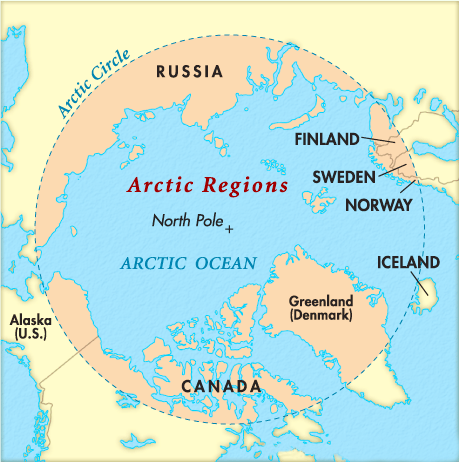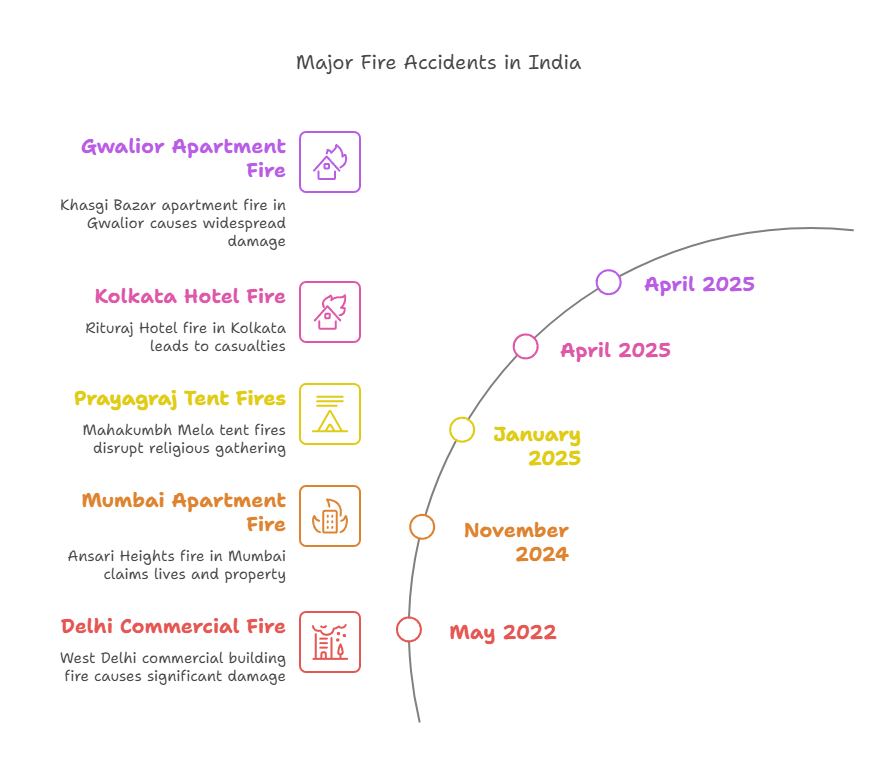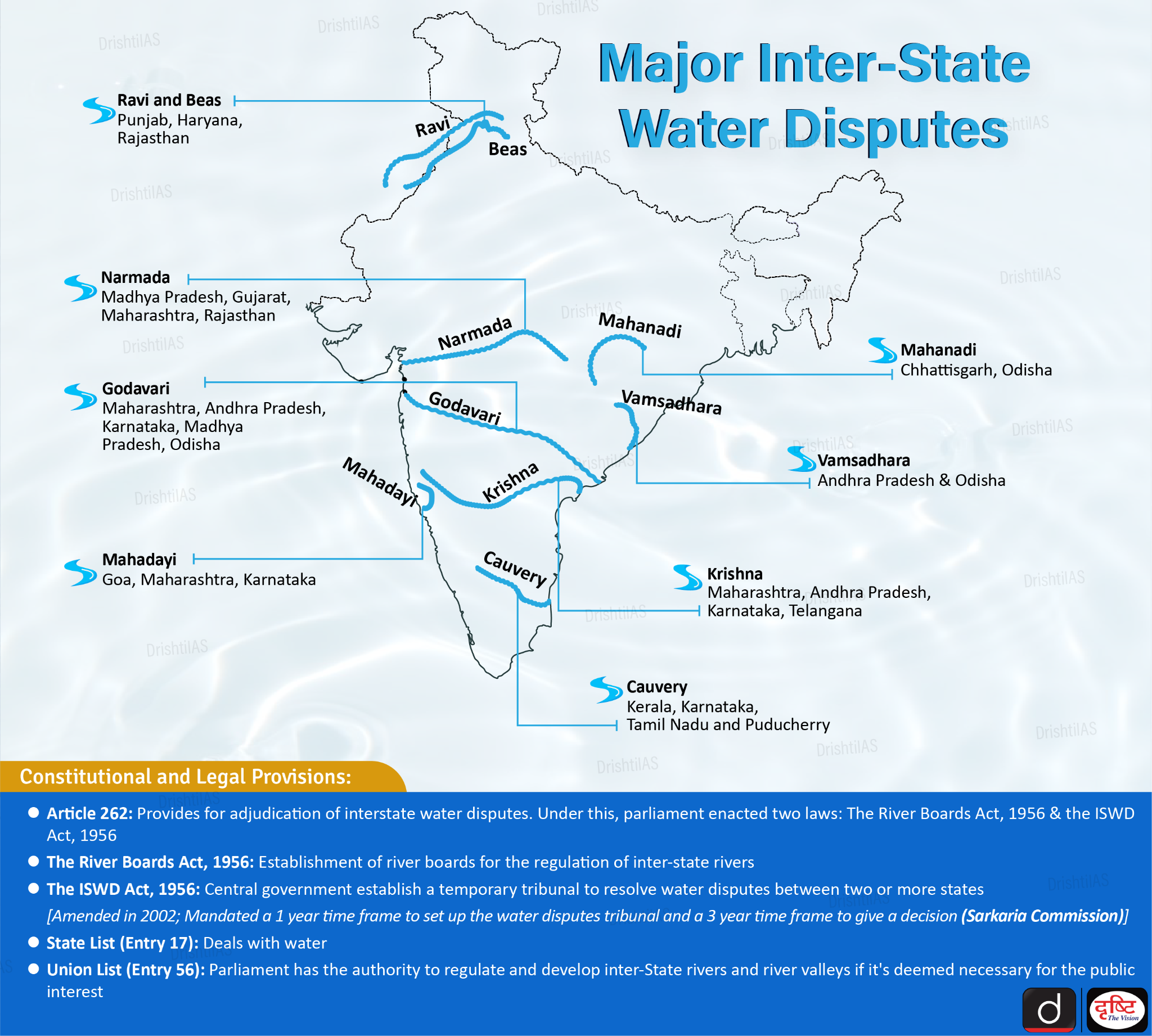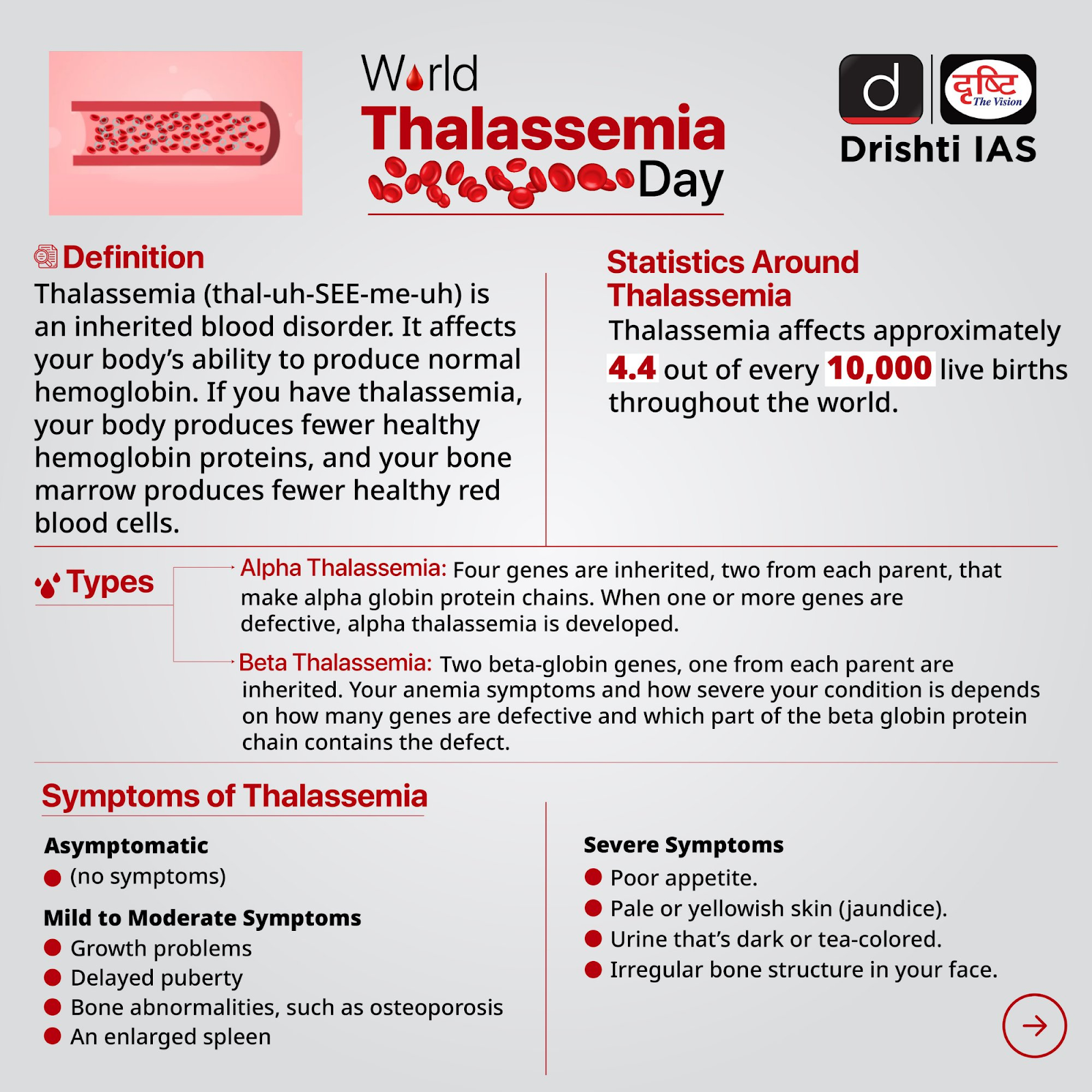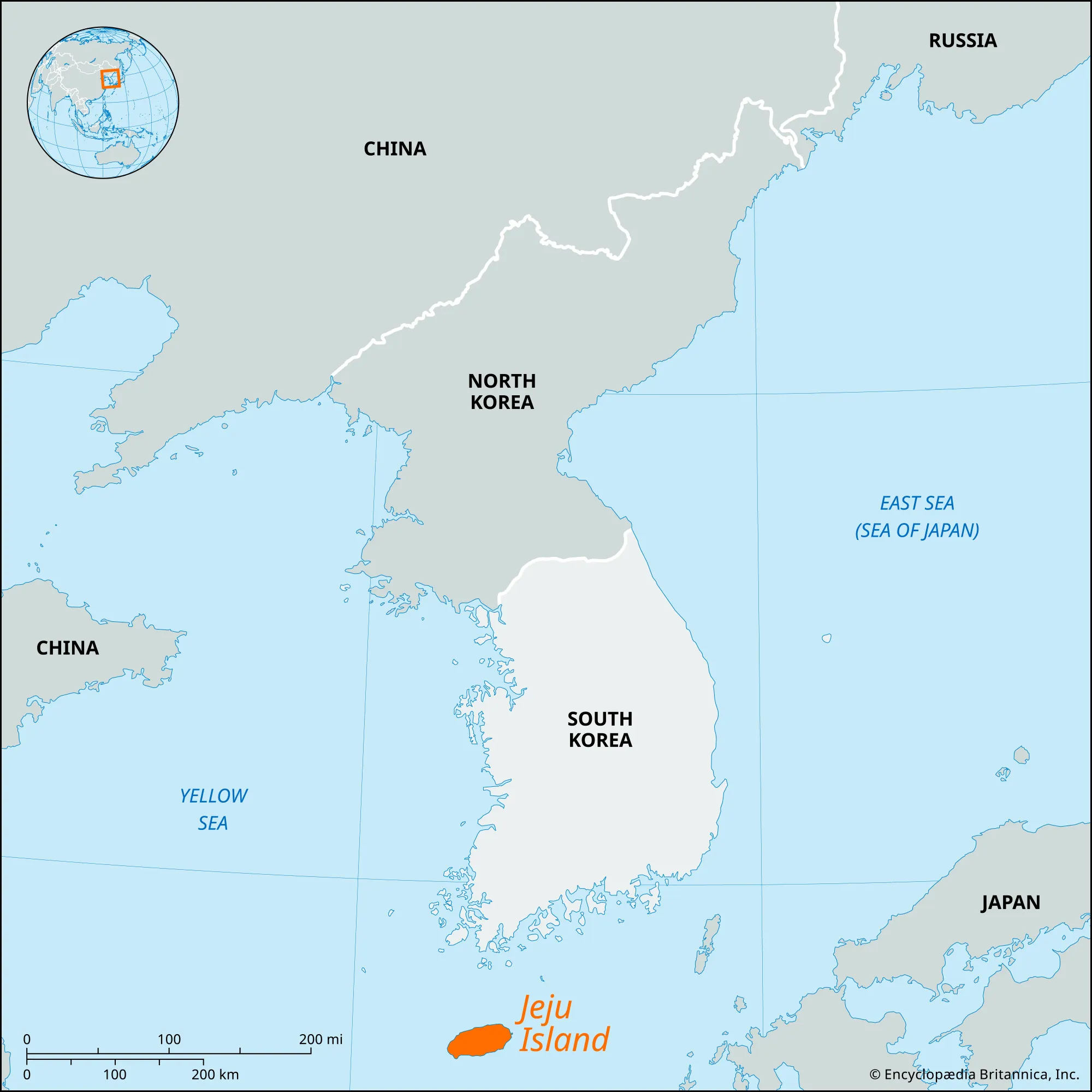Biodiversity & Environment
India and the Dynamism of Arctic Region
For Prelims: Arctic, Northern Sea Route, MAHASAGAR, National Centre for Polar and Ocean Research, Himadri Research Station
For Mains: Geopolitical changes in the Arctic and their global implications, India's role in Arctic governance and its Arctic Policy.
Why in News?
The Arctic, a peaceful zone of scientific cooperation, is rapidly emerging as a geopolitical and military frontier, driven by climate change that is opening new sea routes, especially the Northern Sea Route (NSR) and triggering commercial interest and military buildup.
How Has the Arctic’s Geopolitical Landscape Evolved?
- Climate Change and Resource Access: The opening of the NSR, previously passable only during brief summer months, is now a nearly year-round navigable global trade route.
- This increase in maritime traffic is linked to the Arctic’s untapped natural resources, including oil, gas, and minerals.
- Commercialization and Militarization: Arctic states are reopening old bases, deploying submarines, and showcasing power.
- The Arctic has attracted commercial and military interests, especially from Russia (assertive military deployments), China (expanding Arctic footprint), and the US (renewed focus on Greenland).
- The region is transitioning from a scientific commons to a geopolitical hotspot, central to global power play.
- Potential Impact on India: A militarised Arctic could undermine India’s maritime interests by redirecting trade through the NSR, reducing the relevance of Indian Ocean routes.
- This shift could jeopardize India’s MAHASAGAR (Mutual and Holistic Advancement for Security and Growth Across Regions) Vision for regional connectivity and weaken its role in the Indo-Pacific maritime order.
- India's strong ties with Russia, especially amid the ongoing Ukraine conflict, have raised concerns among Nordic states.
- These relationships may hinder India's ability to forge closer partnerships with Arctic nations, which are cautious of India's perceived strategic alignment with Russia.
Arctic
- About: The Arctic is a region located above the Arctic Circle, north of latitude 66° 34' N, encompassing the Arctic Ocean and surrounding lands, with the North Pole at its center.
- This region includes territories of eight Arctic states: Canada, Denmark (Greenland), Finland, Iceland, Norway, Russia, Sweden, and the USA, who together form the Arctic Council.
- The Arctic is home to nearly 4 million inhabitants, with approximately one-tenth being indigenous peoples.
- Significance: It is rich in natural resources, including coal, diamonds, zinc, and rare earth metals, with Greenland possessing about a quarter of the world's rare earth reserves.
- As India is the 3rd-largest energy consumer, the Arctic's melting ice makes these resources more accessible, potentially addressing India’s energy security needs.
- Geographically, the Arctic regulates ocean currents and reflects solar radiation, helping maintain Earth's temperature.
- Environmentally, the Arctic’s melting ice is linked to glacial changes in the Himalayas, critical for India’s water security.
What is India’s Approach Towards the Arctic?
- Historical Engagement: India’s Arctic engagement began in 1920 with the signing of the Svalbard Treaty.
- The National Centre for Polar and Ocean Research (NCPOR), under the Ministry of Earth Sciences, is the lead agency for India’s Arctic studies.
- Scientific Expeditions: India's Arctic engagement began in 2007 with its first scientific expedition, focusing on biological sciences, ocean and atmospheric sciences, and glaciology.
- In 2008, India established the Himadri Research Station at the Svalbard Arctic research base.
- Himadri is manned for 180 days annually. India has conducted 13 Arctic expeditions since 2007.
- This was followed by the deployment of the IndArc Observatory in 2014 at Kongsfjorden, marking India’s first multi-sensor moored observatory.
- In 2016, India set up its northernmost atmospheric laboratory at Gruvebadet, equipped to study clouds, precipitation, pollutants, and atmospheric parameters.
- In 2008, India established the Himadri Research Station at the Svalbard Arctic research base.
- Arctic Council: India became an Observer nation of the Arctic Council in 2013 and has actively contributed to its six Working Groups.
- India has also engaged with the Arctic Energy Summit, Arctic Science Ministerial, and meetings of Task Forces.
- India's 2022 Arctic Policy: India's Arctic policy focuses on strengthening scientific, climate, and environmental research, enhancing maritime and economic cooperation.
- It aims to deepen understanding of climate change impacts on India’s security and economy, enhance analysis of Arctic ice melt, and explore connections between polar regions and the Himalayas.
- The policy also seeks to foster deeper cooperation with Arctic nations, increase India's participation in the Arctic Council, and improve understanding of Arctic governance and geopolitics.
What are the Gaps in India’s Approach Towards the Arctic?
- Lack of Clear Strategy: India lacks a long-term strategy addressing the region’s geopolitical and economic importance. While focused on sustainability, it does not fully address the growing militarization and geopolitical competition in the Arctic.
- Limited Economic Engagement: India has limited private sector involvement in Arctic business opportunities like resource extraction, shipping, and tourism, leaving its commercial engagement underdeveloped.
- Additionally, India has not capitalized on the NSR, failing to integrate it into its broader economic strategy despite its growing importance due to melting ice and climate change.
- China's growing presence and its Polar Silk Road initiative challenge India’s Arctic strategy. India’s policy needs to address the economic and security implications of China’s increasing influence in the region.
- Underdeveloped Infrastructure Focus: India has overlooked key opportunities in Arctic infrastructure and shipping connectivity.
- As Arctic sea routes become more significant, India's limited involvement in infrastructure projects and absence from shipping ventures puts it at a disadvantage in the region's expanding economy.
- Lack of Indigenous Engagement: India has not developed clear policies for engaging with indigenous communities, which is crucial for responsible development.
- Limited Research Focus: India’s research in the Arctic, through Himadri and IndArc, is significant but could expand to include emerging areas like Arctic biodiversity, marine pollution, and climate-induced migration.
How Should India Recalibrate its Arctic Strategy?
- Institutionalise Arctic Engagement: Establish dedicated Arctic desks in the Ministries of External Affairs and Defence, ensure regular inter-agency coordination, and engage strategic think tanks to frame a broader Arctic outlook beyond science.
- With increasing militarisation of the Arctic, similar trends may emerge in Antarctica; India needs a comprehensive polar policy to prepare for future geopolitical and economic developments at both poles.
- Alignment with Arctic Countries: India should establish an Arctic Technology Hub focused on clean energy, renewable solutions, and the development of ice-safe infrastructure, including ship repair, and ship recycling.
- This would support sustainable Arctic engagement while boosting India’s maritime capabilities and green innovation.
- Strengthen Arctic Connectivity: Establish an India-Russia-Nordic shipping corridor, focusing on green shipping along the NSR.
- The Chennai–Vladivostok Eastern Maritime Corridor (EMC) is now a strategic sea link connecting India’s East Coast with Russia’s Far East. Beyond boosting bilateral trade, it opens a gateway to the Arctic region via Russia’s NSR.
- It enables India to diversify energy imports and strengthen ties with Arctic nations, positioning it as a key player in emerging polar supply chains.
- Blue Economy Treaty: India could propose an Arctic Blue Economy Treaty to balance economic growth and marine conservation.
- The treaty would create a framework for sustainable resource extraction, marine spatial planning, and fisheries management.
- Leveraging its expertise in ocean governance (SAGAR, IPOI), India could lead multilateral efforts to ensure Arctic development preserves ocean health.
- Arctic Monitoring: India should use its space capabilities to create an Arctic Satellite System for real-time monitoring of ice, wildlife, pollution, and resource extraction, offering data-sharing and expertise to Arctic nations, strengthening its role in climate research.
Conclusion
India’s current Arctic posture rooted in science and climate diplomacy was suitable in an era of cooperation. But as the Arctic becomes a theatre of power, India risks strategic irrelevance if it does not recalibrate with purpose. A shift from passive observer to engaged stakeholder is now essential.
|
Drishti Mains Question: The Arctic, once a zone of scientific collaboration, is now a theatre of strategic contestation. Analyze India’s readiness to respond to this shift. |
UPSC Civil Services Examination Previous Year Question (PYQ)
Prelims
Q. Which of the following statements is/are correct about the deposits of ‘methane hydrate’? (2019)
- Global warming might trigger the release of methane gas from these deposits.
- Large deposits of ‘methane hydrate’ are found in Arctic Tundra and under the sea floor.
- Methane in atmosphere oxidizes to carbon dioxide after a decade or two.
Select the correct answer using the code given below.
(a) 1 and 2 only
(b) 2 and 3 only
(c) 1 and 3 only
(d) 1, 2 and 3
Ans: (d)
Mains
Q. How do the melting of the Arctic ice and glaciers of the Antarctic differently affect the weather patterns and human activities on the Earth? Explain. (2021)
Q. What are the economic significance of the discovery of oil in the Arctic Sea and its possible environmental consequences? (2015)


Disaster Management
Fire Safety in India
For Prelims: National Building Code (NBC) 2016, Bureau of Indian Standards (BIS), Model Building Bye Laws 2016.
For Mains: Provision Regarding Fire Safety in India, Issues Leading to Urban Fire in India, Measures to Improve Fire Safety in India
Why in News?
Recent fires in overcrowded buildings across India have become disturbingly common, such as a hotel fire in Kolkata killing 14, including children, and a blaze in Ajmer claiming 4 lives.
Note: According to the Accidental Deaths and Suicides in India (ADSI) report by the National Crimes Records Bureau (NCRB), as many as 7,435 people were killed in over 7,500 fire accidents in 2022.
- Fire Service is a State subject and has been included as a Municipal function in the XII Schedule of the Constitution of India under Article 243(W).
Major Fire Accidents in India
Why Are Urban Areas Prone to Deadly Fires?
- Urbanisation and Infrastructure Issues:
- Illegal Constructions: Unauthorized buildings violate the 3-meter setback rule, blocking ventilation and fire access. Even approved buildings often use non-fire-resistant materials, with old wiring and overloaded systems raising fire risks.
- Poor Urban Planning: Congested layouts and narrow lanes delay the arrival of fire engines and hinder rescue operations. While National Building Code (NBC) 2016 mandates two enclosed staircases of at least 1 meter width for buildings over 15m, many older buildings with just one staircase become deadly during fires.
- Governance Challenges:
- Political Interference: Illegal colonies are often regularized during elections without fire safety upgrades, while stricter rules like Delhi’s 2019 fire safety amendments have been rolled back under pressure from builders.
- Lack of Public Awareness: Residents and businesses often ignore fire drills and get trapped due to unfamiliarity with exits, while commercial spaces are misused for storage in stairwells or illegal factories in basements.
- Industrial and Commercial Oversights:
- Faulty Machinery and Poor Maintenance: Overheated equipment or unserviced Heating, ventilation, and air conditioning (HVAC) systems in workplaces.
- Unsafe Handling of Hazardous Materials: Chemical spills or gas leaks in factories triggering explosions.
- Climate-Driven Threats:
- Severe heat: Extreme heat caused by climate change leads to excessive use of air conditioners, which can overload electrical systems, and in some cases result in AC compressor bursts, increasing the risk of fire incidents in urban areas.
What are the Key Fire Safety Regulations in India?
- National Building Code (NBC): NBC, developed by the Bureau of Indian Standards (BIS), was first introduced in 1970, with its third edition released in 2016.
- It serves as the primary standard for fire safety in India, offering guidelines on general construction, maintenance, exit routes, and fire safety measures for buildings.
- State governments are required to integrate its recommendations on minimum fire safety and rescue protocols into their local bylaws.
- Model Building Bye Laws 2016: It ensures fire safety through its key provisions like use of fire-resistant materials for construction, installation of fire alarms and detection systems, adequate natural light and ventilation to avoid smoke buildup etc.
- Fire Prevention and Fire Safety Act, 2005: It is designed to ensure fire safety in buildings and must be upheld by all states to consolidate and update laws related to fire prevention and safety.
- Model Bill to Provide for the Maintenance of Fire and Emergency Service for the State, 2019: It offers a model framework for states to manage fire and emergency services effectively.
- Scheme for Expansion and Modernization of Fire Services in the States 2023: It was launched by the Central Government in 2023 after the 15th Finance Commission recommended Rs 5,000 crore to strengthen fire services at the state level.
- Fire Safety Week: Union Health Ministry observes Pan-India ‘Fire Safety Week’ from 21st to 25th April' to raise awareness about fire prevention and safety practices across the country.
- NDMA Guidelines: The National Disaster Management Authority (NDMA) has also laid out guidelines on fire safety at homes, schools, and hospitals.
How can Urban Areas be Made Fire-resilient?
- Infrastructure Modernization:
- Smart Infrastructure: Lowered sidewalks aid fire engine access, while AI detection, self-regulating grids, and fire-resistant materials boost fire safety. Retractable staircases offer extra emergency exits in high-rises.
- Retrofitting Fire-Retardant Materials: Retrofitting buildings with fire-retardant materials (such as flame-resistant paints, coatings, and insulation) can reduce the speed and intensity of a fire.
- Overhauling Firefighting:
- More Breathing Apparatuses: Increasing the number of breathing apparatuses for firefighting personnel ensures more firefighters can enter smoke-filled buildings to conduct rescues without suffocating.
- Safe Industrial Practices:
- Industrial risk management: Industries should phase out the use of hazardous materials and adopt safe storage protocols, ensuring that any chemicals or substances that could contribute to a fire are handled with strict safety measures.
- Climate Resilience:
- Innovative Strategies: Green spaces as firebreaks, water recycling systems for firefighting reserves, and predictive analytics to forecast fire risks can enhance fire prevention and response strategies.
Conclusion
The threat of deadly urban fires is not static—it evolves with climate change, population density, and technological complexity. However, cities are not powerless. By embracing innovation, collaboration, and proactive governance, urban areas can transform into fire-resilient ecosystems capable of withstanding tomorrow’s challenges. The blueprint for fire-resilient cities exists; now is the time to build it.
|
Drishti Mains Question: Q. Unplanned urbanization and population density have exacerbated fire hazards in Indian cities. Discuss with examples. |


Governance
Punjab-Haryana Water Sharing Dispute
For Prelims: Supreme Court, Punjab Reorganisation Act, 1966, Beas-Satluj Link Project, Tehri Dam, Article 262, Interstate River Water Disputes Act, 1956, Inter-state Council, PMKSY.
For Mains: Punjab-Haryana water sharing dispute, Inter-state water dispute and resolution.
Why in News?
Punjab opposes the Bhakra Beas Management Board (BBMB)’s decision to release an additional 4,500 cusecs of water to Haryana.
- Meanwhile, Haryana has threatened to move the Supreme Court to secure its share, escalating a decades-old dispute over sharing the water of Bhakra Nangal Dam.
What are the Key Facts Regarding the Punjab-Haryana Water Sharing Dispute?
- Current Crisis: Haryana demanded 8,500 cusecs from the Bhakra-Nangal project—4,500 cusecs more than its current allocation. Punjab refused, forcing the BBMB to intervene.
- In a BBMB meeting, Haryana, Rajasthan, and Delhi voted in favor of releasing extra water.
- Punjab has refused to open additional sluice gates, leading Haryana to approach the Supreme Court.
- Role of BBMP: Before the division of Punjab in 1966, the Bhakra-Nangal project was managed by Punjab. In 1966, the Bhakra Management Board (BMB) was formed under the Punjab Reorganisation Act, 1966 to oversee the project, ensuring it benefited Punjab, Haryana, and Himachal Pradesh.
- BMB was renamed BBMB in 1976, it now manages Bhakra Dam (Himachal), Nangal Dam (Punjab), Beas-Satluj Link Project (Pandoh Dam), and Pong Dam.
- Bhakra Nangal Dam: It comprises two separate but complementary dams on the River Satluj i.e., the Bhakra dam in Himachal Pradesh, and the Nangal dam (10 km downstream in Punjab).
- It is India’s 2nd tallest dam after the Tehri Dam and its reservoir is known as the Gobind Sagar.
- It is a joint venture of 3 state governments - Rajasthan, Haryana, and Punjab.
- After, creation of Haryana, the Satluj-Yamuna Link (SYL) canal was proposed to deliver Haryana’s share but remains incomplete due to Punjab’s resistance.
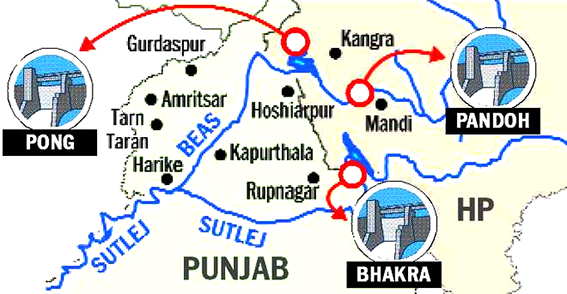
Why are Punjab and Haryan Facing a Water Crisis?
- Groundwater Depletion: Groundwater depletion has become a serious concern in Punjab, Rajasthan, and Haryana, where the extraction rate has exceeded the recharge rate by 66, 51, and 34%, respectively.
- Falling Water Levels: Dams like Bhakra, Pong, and Ranjit Sagar are experiencing significantly lower water levels, attributed to reduced snowfall in the Himalayas, which feeds these rivers.
- Agricultural Practices: Water-intensive crops, especially rice, have worsened groundwater depletion.
- Subsidies for electricity and free water in states like Punjab and Haryana encourage unregulated pumping.
- Indus Waters Treaty (1960): The treaty limits India’s access to the western rivers (Indus, Chenab, Jhelum), vital for irrigation in Punjab and other states, causing regional water stress.
- Urban & Industrial Demand Surge: Rapid urbanization in cities like Chandigarh, Gurugram, and Ludhiana has increased domestic water demand, while thermal power plants and industries further strain limited water resources.
What is the Interstate River Water Dispute?
- About: Interstate river water disputes arise when two or more states disagree over the usage, distribution, or control of rivers that flow across their boundaries.
- Causes:
- Riparian Rights: Conflicts between upstream and downstream states over equitable water distribution.
- Water Sharing Agreements: Ambiguities in agreements often fuel disputes when one state feels aggrieved by unequal shares or unfair allocations.
- Water Scarcity & Climate Change: Increased competition due to droughts and changing weather patterns.
- Political and electoral considerations complicate dispute resolution.
- Agriculture vs Industry: Tensions between agricultural and industrial water needs.
- Economic Disparities: Wealthier states with better infrastructure dominate water access.
- Legal Delays: Prolonged tribunals or Supreme Court judgments delay resolution.
- Constitutional Provisions:
- Entry 56 of the Union List: It grants the Union Government authority to regulate and develop inter-state rivers and river valleys, as deemed necessary by Parliament for public interest.
- Entry 32 of the Concurrent List: It is related to shipping and navigation on inland waterways as regards mechanically propelled vessels, and the rule of the road on such waterways.
- Entry 17 of the State List: It pertains to water, covering aspects such as water supply, irrigation, canals, drainage, embankments, water storage, and hydro power.
- Disputes Resolution Provisions:
- Constitution: According to Article 262, in case of disputes relating to waters:
- Parliament has the authority to enact laws for the adjudication of any dispute or complaint regarding the use, distribution, or control of waters in any inter-State river or river valley.
- Parliament may, through legislation, specify that neither the Supreme Court nor any other court shall have jurisdiction over such disputes or complaints as mentioned above.
- Statutory: As per Article 262, the Parliament has enacted:
- River Board Act, 1956: This empowered the Union government to establish Boards for Interstate Rivers and river valleys in consultation with State Governments. So far, no river board has been established under this Act.
- Inter-State Water Dispute Act, 1956: If a state or states request a tribunal, the Central Government should first try to resolve the issue through consultation. If unsuccessful, it may then constitute the tribunal.
- The Supreme Court shall not question the Award or formula given by tribunal, but it can question the working of the tribunal.
- It was amended in 2002 that specified a one-year deadline for the establishment of a water disputes tribunal and a three-year deadline for delivering a decision as per the Sarkaria Commission recommendations.
- Constitution: According to Article 262, in case of disputes relating to waters:
- Major Interstate River Water Disputes:
How to Solve Interstate River Water Dispute?
- Strengthening Institutional Frameworks: Amend the Interstate River Water Disputes Act, 1956 to include penalties for non-compliance (such as reduction of central funding), and the establishment of a single permanent tribunal (as proposed in the 2019 amendment) with specialized benches.
- Cooperative Federalism & Mediation: Introduce mediation and negotiation before litigation, involving neutral mediators such as retired judges and hydrologists, alongside political dialogue through platforms like PM-led inter-state council.
- Scientific Water Management: Provide subsidies for drip and sprinkler irrigation (similar to PMKSY) and promote crop diversification to reduce water-intensive crops like sugarcane in drought-prone areas.
- Rainwater Harvesting: Implement a national policy for aquifer recharge and penalize over-extraction of groundwater (e.g., Punjab’s depleting resources) to ensure sustainable water usage.
- The INDIA-Groundwater Resource Estimation System (IN-GRES), which tracks and maps groundwater extraction, should be implemented nationwide for effective groundwater management based on its criticality.
- Balanced Infrastructure Development: Ensure equitable water infrastructure development that balances the interests of all states, while promoting decentralized conservation to reduce reliance on large-scale structures amid climate change and variable river flows.
Conclusion
The Punjab-Haryana water dispute highlights the complexities of interstate river water sharing, exacerbated by legal, political, and environmental challenges. Effective resolution requires strengthening institutional frameworks, fostering cooperative federalism, implementing scientific water management, and ensuring equitable infrastructure development to address the needs of all states and promote sustainable water use.
|
Drishti Mains Question: Q.Examine the causes and challenges of interstate river water disputes in India. How can the existing legal and institutional frameworks be strengthened to ensure timely resolution? |
UPSC Civil Services Examination, Previous Year Question (PYQ)
Mains
Q. Constitutional mechanisms to resolve the inter-state water disputes have failed to address and solve the problems. Is the failure due to structural or process inadequacy or both? Discuss. (2013)


Important Facts For Prelims
Microplastic Infiltration in Oceans
Why in News?
A recent study published in Nature reveals that microplastics are not just surface pollutants but are now embedded deep within the ocean, impacting the planet's biogeochemical and carbon cycles.
What are Key Findings of the Study?
- Microplastic Infiltration: Microplastics are widespread across the ocean, dominating marine ecosystems and reaching depths of up to 100 metres in ocean gyres.
- While larger plastic fragments (100 to 5,000 micrometres) were typically concentrated near the ocean surface, smaller particles were discovered embedded as deep as 100 metres within ocean gyres.
- Gyres, slow-moving, circular ocean currents, trap and concentrate plastics.
- Quantity: The total plastic input from 1950–2015 was estimated at 17–47 million metric tonnes.
- Fishing gear made of nylon and polyester is a key source of dense plastics like Polyethylene Terephthalate (PET) in the ocean, with over 56 polymer types detected.
- Impacts: The water column, vital for biogeochemical cycling, is increasingly affected by microplastics, potentially disrupting the ocean’s carbon cycle.
- Carbon Cycle Interference: Plastic pollution adds external carbon (called allochthonous carbon) to marine ecosystems, with microplastic carbon rising from 0.1% of total particulate organic carbon (POC) at 30 m to 5% at 2,000 m in subtropical gyres.
- It could make marine samples appear 420 years older.
- Biogeochemical Impacts: Microplastics alter microbial nitrification and denitrification and release metabolites that disrupt nutrient cycles.
- Carbon Cycle Interference: Plastic pollution adds external carbon (called allochthonous carbon) to marine ecosystems, with microplastic carbon rising from 0.1% of total particulate organic carbon (POC) at 30 m to 5% at 2,000 m in subtropical gyres.
What are Microplastics?
- About: Microplastics, defined as plastics less than five millimetres in diameter, can be harmful to oceans and aquatic life.
- Solar UV radiation, wind, and ocean currents break down plastics into microplastics (<5 mm) and nanoplastics (<100 nm).
- Classification:
- Primary microplastics: They are tiny particles made for commercial use, like microbeads, plastic pellets, and microfibers from clothing.
- Secondary microplastics: They form when larger plastics like bottles break down due to sunlight and ocean currents.
- Concerns: Microplastics can attach to red blood cells, reducing oxygen transport, and have been found in placentas and fetal organs.
- They can damage human cells, and young children are especially vulnerable to such exposure.
- Applications: It is used in drug delivery, industrial cleaning, and as exfoliants in personal care products like scrubs and toothpaste.
- Regulations Related to Microplastics:
UPSC Civil Services Exam, Previous Year Questions (PYQ)
Q. Why is there a great concern about the ‘microbeads’ that are released into environment? (2019)
(a) They are considered harmful to marine ecosystems.
(b) They are considered to cause skin cancer in children.
(c) They are small enough to be absorbed by crop plants in irrigated fields.
(d) They are often found to be used as food adulterants.
Ans: (a)


Rapid Fire
INS Sharda to Maldives for HADR
INS Sharda arrived at Maafilaafushi Atoll, Maldives, for a joint Humanitarian Assistance and Disaster Relief (HADR) exercise with the Maldives National Defence Force (MNDF).
- The exercise is part of India's "MAHASAGAR (Mutual and Holistic Advancement for Security and Growth Across Regions)" vision in the Indian Ocean Region (IOR).
- Earlier, following the 2004 Indian Ocean tsunami, the Indian Navy, as part of its HADR operations, launched Operation Castor to provide vital relief to the Maldives during the crisis.
- The HADR exercise aims to enhance interoperability between the Indian Navy and MNDF to respond effectively to humanitarian challenges.
- INS Sharda (P55), a Sukanya-class patrol vessel, was awarded the ‘On the Spot Unit Citation’ for rescuing 19 hostages from the hijacked Iranian vessel Omari off Somalia in 2024, showcasing operational excellence and reinforcing India’s maritime security role in the IOR.
- Exercises Between India and Maldives: Bilateral exercises include “Ekuverin (Army)” and “Ekatha (Navy)”, while the trilateral coast guard exercise “Dosti” is conducted with Sri Lanka.
Atoll: An atoll is a ring-shaped coral reef, island, or series of islets. It surrounds a body of water called a lagoon.
| Read more: Strengthening India-Maldives Defence Cooperation |


Rapid Fire
Green Hydrogen Certification Scheme of India (GHCI)
The Ministry of New and Renewable Energy (MNRE) has launched the Green Hydrogen Certification Scheme of India (GHCI) under the National Green Hydrogen Mission (NGHM).
- About: It is an initiative to create a robust framework for certifying green hydrogen (GH) production and ensuring transparency, traceability, and market credibility.
- Objective: Promote a Green Hydrogen market in India, sourced from renewables to cut carbon emissions, drive exports, and encourage energy-intensive sectors to adopt the fuel.
- International port cities like Kandla, Paradip, and Tuticorin have been chosen as main centers for producing green hydrogen for export.
- It will curb greenwashing, where companies deceptively portray themselves as eco-friendly through false or exaggerated claims.
- Certification Process: It will be verified by the Bureau of Energy Efficiency (BEE) Accredited Carbon Verification (ACV) Agency to ensure compliance.
- The certificate is non-transferable, non-tradeable, and cannot be used to claim emission reduction credits.
- BEE has also announced an offset mechanism for hard-to-abate sectors (e.g., cement) using green hydrogen under CCTS, to allow them to earn and trade credit.
- Applicability: The certification scheme applies only to green hydrogen production from electrolysis or conversion of biomass.
| Read More: National Green Hydrogen Mission |


Rapid Fire
World Red Cross and Red Crescent Day
World Red Cross and Red Crescent Day is observed annually on 8th May to honour the humanitarian efforts of millions of volunteers worldwide.
- Theme 2025: "Keeping Humanity Alive" reflects a commitment to humanitarian service amid rising inequalities, health crises, and conflicts.
- Historical Background: The day was established in 1948 to commemorate the birth of Henry Dunant, born on 8th May 1828, who was the founder of the International Committee of the Red Cross (ICRC) and the first Nobel Peace Prize laureate, sharing the award with Frédéric Passy.
- After witnessing the horrors of the Battle of Solferino (1859), Dunant advocated for humanitarian aid bodies, leading to the formation of the ICRC in 1863 and later the Geneva Conventions.
- The International Red Cross and Red Crescent Movement, with over 80 million members, includes the ICRC, 191 National Societies, it provides protection and aid during conflicts and disasters, upheld by the red cross, red crescent, and red crystal emblems.
- Significance: The day honors volunteers aiding in emergencies, wars, and disasters, while promoting principles of humanity, impartiality, and neutrality.
- Indian Red Cross Society (IRCS): Founded in 1920, provides disaster relief and healthcare, with the President of India as its President and the Union Health Minister as its Chairman.
| Read more: World Red Cross Day |


Rapid Fire
International Thalassemia Day
International Thalassemia Day is observed every year on 8th May as a global effort for prevention, awareness and early diagnosis for inherited blood disorder disease Thalassemia.
- The theme for 2025 is "Together for Thalassemia: Uniting Communities, Prioritizing Patients".
- About Thalassemia:
- Burden: India, termed the "Thalassemia capital," has 50 million beta thalassemia carriers and contributes to 25% of global cases.
- Treatment: It includes regular blood transfusions to maintain healthy red cell levels, managed with iron chelation therapy to prevent iron overload.
- In severe cases, bone marrow or stem cell transplant offers a potential cure.
- Initiatives for Eradication:
- Under the National Health Mission (NHM), States/UTs receive support for thalassemia screening, treatment, and related infrastructure.
- The government recommends integrating thalassemia testing into the Reproductive and Child Health (RCH) program for early carrier detection and genetic counseling to reduce the disease burden.
- National Program for Prevention and Control of Hemoglobinopathies (NPPCH) to raise awareness, offer counseling and testing services for affected individuals.
- Thalassemia Bal Sewa Yojana (TBSY) provides financial aid for Bone Marrow Transplants through Coal India Ltd.’s CSR in 17 empanelled hospitals nationwide.
- Under the National Health Mission (NHM), States/UTs receive support for thalassemia screening, treatment, and related infrastructure.
| Read More: International Thalassemia Day |


Rapid Fire
Genetic Adaptations in the Haenyeo
The Haenyeo, a group of women divers from South Korea’s Jeju Island, have been found to exhibit both genetic adaptations and physiological changes related to their unique diving practices.
- Long-term diving practice and natural selection have shaped traits like bradycardia (slowing of heart rate), blood pressure regulation, and cold tolerance.
- About Haenyeo: They dive up to 10 meters underwater to harvest shellfish like abalone and sea urchins for a living, without the use of oxygen masks.
- Their culture has been recognized by UNESCO as part of the Intangible Cultural Heritage since 2016.
- About Jeju Island: It is a volcanic island (made of basalt and lava) in South Korea, and home to the country's tallest mountain Hallasan (dormant volcano, 1,950 meters).
- The Jeju Volcanic Island and Lava Tubes are a UNESCO World Heritage Site, known for their unique geology and 360 satellite volcanoes around the main volcano.
| Read More: UNESCO's List of Intangible Cultural Heritage (ICH) |



